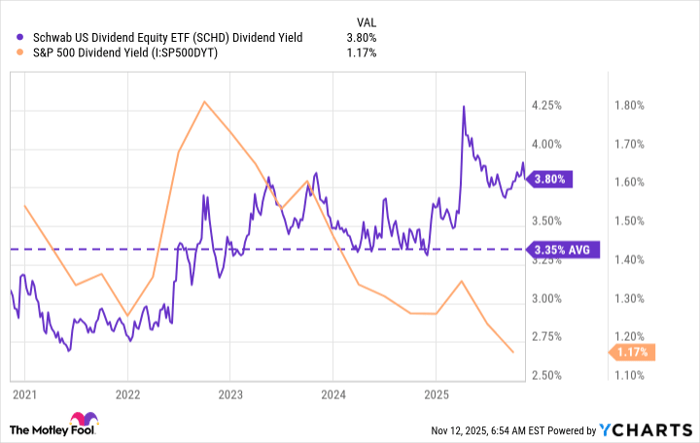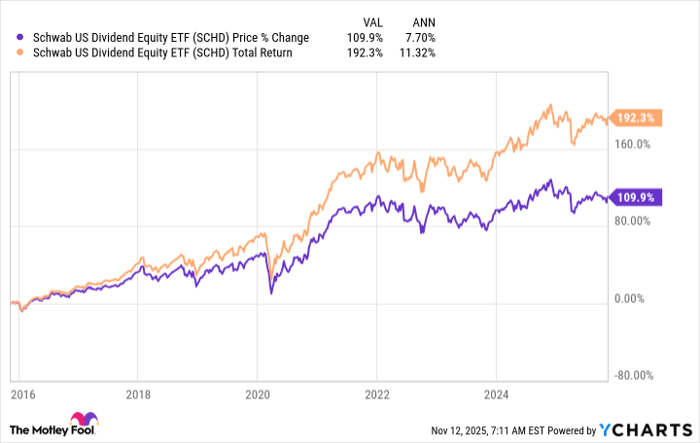1 No-Brainer Dividend ETF to Buy Right Now for Less Than $1,000
Key Points
This Schwab ETF has averaged an 11%-plus annualized total return over the past decade.
A company must have at least 10 consecutive years of dividend payouts to be included.
Reinvesting dividends for more shares is a great way to build upon a strong base.
- 10 stocks we like better than Schwab U.S. Dividend Equity ETF ›
One reason I'm a fan of dividend exchange-traded funds (ETFs) is that they combine two of my favorite parts of investing: guaranteed income and ETFs. Stock price appreciation is great and undoubtedly appreciated, but it's nice to own dividend stocks and know you'll get rewarded regardless of the stock's price movements.
And ETFs are great because they allow you to cover a lot of ground and check many investing boxes with just a few investments. Combine the two, and voilà -- you have an investment that can be rewarding and less risky than investing in individual stocks.
Where to invest $1,000 right now? Our analyst team just revealed what they believe are the 10 best stocks to buy right now. Continue »
It doesn't require a significant amount of money to receive value from a dividend ETF, either. Even if you have less than $1,000 to invest, the following dividend ETF is a great option to consider adding to your portfolio.

Image source: Getty Images.
One of the best dividend ETFs on the market
If you're looking for a high-quality dividend ETF, look no further than Schwab U.S. Dividend Equity ETF (NYSEMKT: SCHD). Mirroring the Dow Jones U.S. Dividend 100 index, SCHD has criteria that essentially act as a de facto vet for you. To be included in the ETF, a company must have at least 10 consecutive years of dividend payouts, a healthy balance sheet, and solid cash flow.
Below are some notable names included from different major sectors of the U.S. economy:
- Energy (19.34% of the ETF): Chevron and ConocoPhillips
- Consumer staples (18.50%): Coca-Cola and PepsiCo
- Health care (16.10%): AbbVie and Merck
- Industrials (12.28%): Lockheed Martin and United Parcel Service
- Financials (9.37%): Fifth Third Bancorp and T. Rowe Price
When you invest in SCHD, you can be confident that you're investing in an ETF that contains a diverse portfolio of high-quality companies. Most of them are large-cap stocks, with 58% of the companies in SCHD having a market cap of over $70 billion.
A dividend yield worth paying attention to
When looking at the upper tier of dividend ETFs, SCHD has one of the higher dividend yields out there. At the time of this writing, its yield is 3.8%, which is three times higher than the S&P 500 average. It's also slightly higher than its average for the past five years.

SCHD Dividend Yield data by YCharts
Dividend yields fluctuate with stock prices, but over the past couple of years, SCHD has consistently had a yield that's higher than many S&P 500 dividend stocks and the S&P 500 itself.
A great way to approach investing in SCHD
If you invest $1,000 into SCHD and it maintains a 3.8% yield (which it won't, but we'll assume so for the sake of illustration), it would pay out $38 annually. This isn't life-changing money by any means, so it can often be more impactful if you reinvest the dividends to acquire more shares.
Most brokerage platforms offer a dividend reinvestment plan (DRIP), which automatically reinvests the dividends you receive in additional shares of the stock or ETF that paid them. This makes the process seamless, operating behind the scenes. Ideally, you'd keep reinvesting the dividends for more shares until you've acquired enough to receive a decent amount whenever you decide to begin receiving cash payouts.
Over the past decade, SCHD has averaged 11.3% total annual returns. With an 11% annual average, a single $1,000 investment would grow to just over $8,000 in 20 years, which would then pay out around $300 annually with a 3.8% yield. If you added $100 monthly, it would grow to around $85,100, paying out over $3,200 annually.

SCHD data by YCharts
The specific dollar figures will obviously vary based on returns, but this example shows how powerful compound earnings can be, especially regarding dividends and taking advantage of your brokerage platform's DRIP. The Schwab U.S. Dividend Equity ETF has all the tools (and holdings) to be a great long-term investment. The key is patience.
Should you invest $1,000 in Schwab U.S. Dividend Equity ETF right now?
Before you buy stock in Schwab U.S. Dividend Equity ETF, consider this:
The Motley Fool Stock Advisor analyst team just identified what they believe are the 10 best stocks for investors to buy now… and Schwab U.S. Dividend Equity ETF wasn’t one of them. The 10 stocks that made the cut could produce monster returns in the coming years.
Consider when Netflix made this list on December 17, 2004... if you invested $1,000 at the time of our recommendation, you’d have $599,784!* Or when Nvidia made this list on April 15, 2005... if you invested $1,000 at the time of our recommendation, you’d have $1,165,716!*
Now, it’s worth noting Stock Advisor’s total average return is 1,035% — a market-crushing outperformance compared to 191% for the S&P 500. Don’t miss out on the latest top 10 list, available when you join Stock Advisor.
See the 10 stocks »
*Stock Advisor returns as of November 10, 2025
Stefon Walters has positions in Coca-Cola. The Motley Fool has positions in and recommends AbbVie, Chevron, Merck, T. Rowe Price Group, and United Parcel Service. The Motley Fool recommends Lockheed Martin. The Motley Fool has a disclosure policy.



